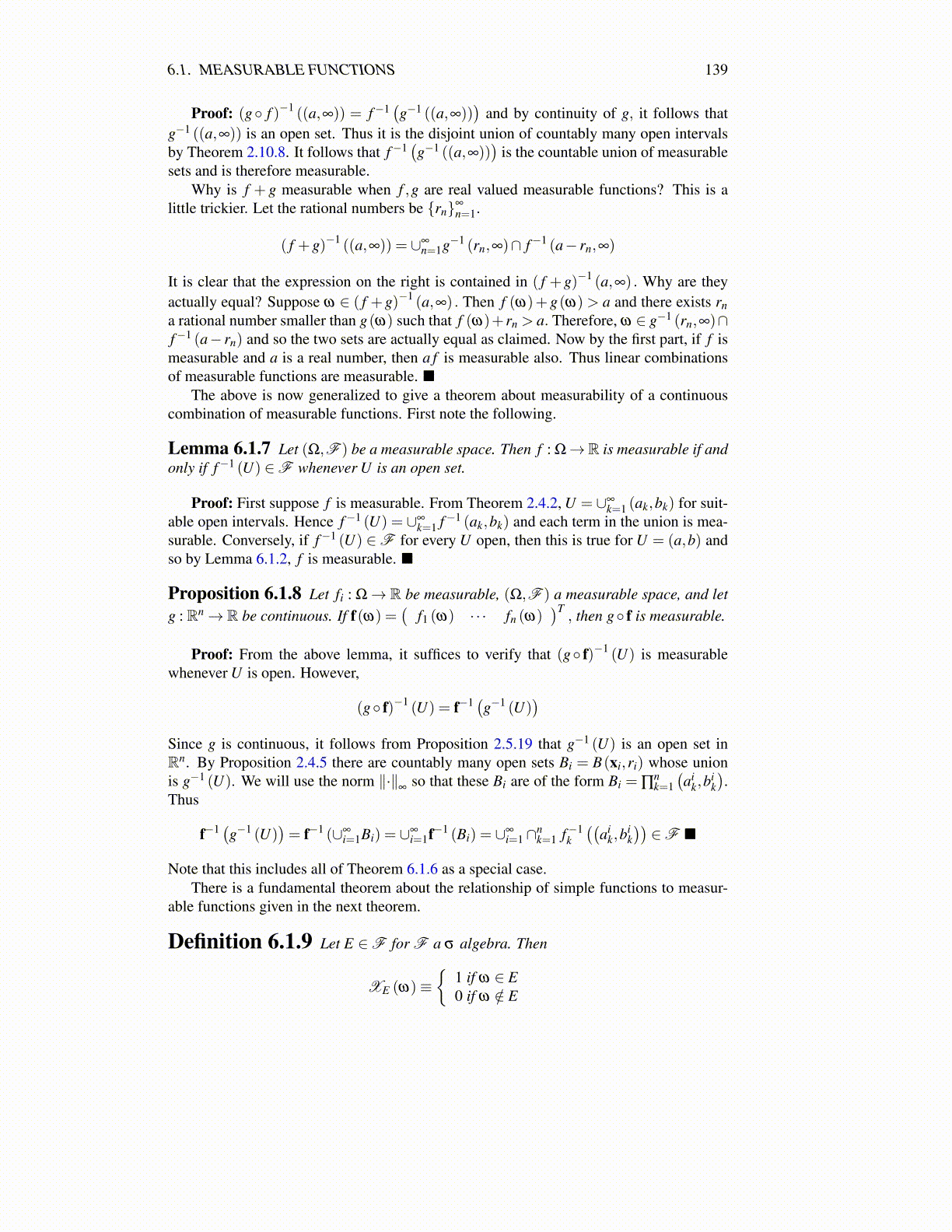
6.1. MEASURABLE FUNCTIONS 139
Proof: (g◦ f )−1 ((a,∞)) = f−1(g−1 ((a,∞))
)and by continuity of g, it follows that
g−1 ((a,∞)) is an open set. Thus it is the disjoint union of countably many open intervalsby Theorem 2.10.8. It follows that f−1
(g−1 ((a,∞))
)is the countable union of measurable
sets and is therefore measurable.Why is f + g measurable when f ,g are real valued measurable functions? This is a
little trickier. Let the rational numbers be {rn}∞
n=1.
( f +g)−1 ((a,∞)) = ∪∞n=1g−1 (rn,∞)∩ f−1 (a− rn,∞)
It is clear that the expression on the right is contained in ( f +g)−1 (a,∞) . Why are theyactually equal? Suppose ω ∈ ( f +g)−1 (a,∞) . Then f (ω)+g(ω)> a and there exists rna rational number smaller than g(ω) such that f (ω)+ rn > a. Therefore, ω ∈ g−1 (rn,∞)∩f−1 (a− rn) and so the two sets are actually equal as claimed. Now by the first part, if f ismeasurable and a is a real number, then a f is measurable also. Thus linear combinationsof measurable functions are measurable. ■
The above is now generalized to give a theorem about measurability of a continuouscombination of measurable functions. First note the following.
Lemma 6.1.7 Let (Ω,F ) be a measurable space. Then f : Ω→R is measurable if andonly if f−1 (U) ∈F whenever U is an open set.
Proof: First suppose f is measurable. From Theorem 2.4.2, U = ∪∞k=1 (ak,bk) for suit-
able open intervals. Hence f−1 (U) = ∪∞k=1 f−1 (ak,bk) and each term in the union is mea-
surable. Conversely, if f−1 (U) ∈F for every U open, then this is true for U = (a,b) andso by Lemma 6.1.2, f is measurable. ■
Proposition 6.1.8 Let fi : Ω→ R be measurable, (Ω,F ) a measurable space, and letg : Rn→ R be continuous. If f(ω) =
(f1 (ω) · · · fn (ω)
)T, then g◦ f is measurable.
Proof: From the above lemma, it suffices to verify that (g◦ f)−1 (U) is measurablewhenever U is open. However,
(g◦ f)−1 (U) = f−1 (g−1 (U))
Since g is continuous, it follows from Proposition 2.5.19 that g−1 (U) is an open set inRn. By Proposition 2.4.5 there are countably many open sets Bi = B(xi,ri) whose unionis g−1 (U). We will use the norm ∥·∥
∞so that these Bi are of the form Bi = ∏
nk=1(ai
k,bik
).
Thus
f−1 (g−1 (U))= f−1 (∪∞
i=1Bi) = ∪∞i=1f−1 (Bi) = ∪∞
i=1∩nk=1 f−1
k
((ai
k,bik))∈F ■
Note that this includes all of Theorem 6.1.6 as a special case.There is a fundamental theorem about the relationship of simple functions to measur-
able functions given in the next theorem.
Definition 6.1.9 Let E ∈F for F a σ algebra. Then
XE (ω)≡{
1 if ω ∈ E0 if ω /∈ E